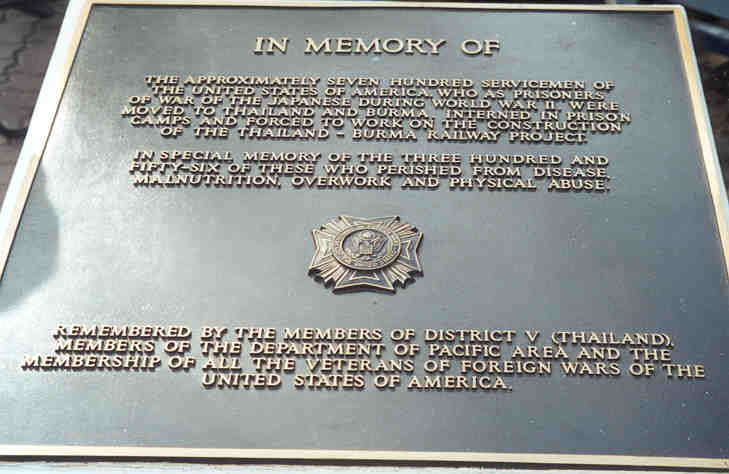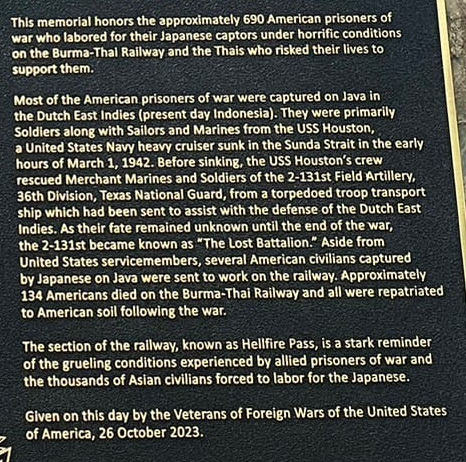One of the mandates in the Congressional Charter of the VFW is to “perpetuate the memory and history of our dead”. IAW such, I set out on a quest to document these POWs and their final resting places. In 1997, the Veterans of Foreign Wars District 5 in Thailand [1] had placed a memorial plaque adjacent to the Bridge over the River Kwai in Kanchanaburi. [see Section 14.1]
I had always heard that the numbers displayed on that memorial were in dispute. It reads that “approximately 700” US POWs worked the railway and 356 died in the process. It seems the second number is quite inaccurate! The best data I can find via multiple sources is that 684 US POWs were in Thailand or Burma of whom 131 (18%) died there. 65 of those were Army, 62 were Navy & 4 Marines; plus a number of them died post-TBR or soon after liberation from POW-related issues.
The US POWs were less than 1% of the military prisoners who worked the railway. Most were British (29,472; 48%), Australians (23,002; 21%); Dutch (17,985; 29%); for a grand total of over 61,000. But even this figure pales compared to the number of Asian Forced Laborers (aka romusha) who may have numbered over 500,000! [see Section 20.] The US POWs came mainly from two groups: survivors of the sinking of the USS Houston (CA-30) in the Strait of Sundra in MAR 1942 and members of the 131 Field Artillery (FA) Regiment (Texas National Guard; TXNG) who had been deployed to the island of Java in JAN 1942 to assist the Dutch Army. Most of the Dutch prisoners were Army (aka KNIL) captured at the same time when the island was overrun by the Japanese. The British and Australians came mainly from the fall of Singapore but others were also captured in the Dutch East indies (DEI). Only 336 members of the USS HOUSTON crew of 937 survived the sinking and were taken prisoner as they made their way ashore. Just about 300 of those Sailors (273) and Marines (27) were eventually sent to Burma and/or Thailand to build the railway. They joined the 374 Soldiers affiliated with the 131st FA Regiment.
In addition, there were 7 Merchant Mariners who survived the sinking of the SS Sawolka who were sent to the TBR. All of whom survived their captivity. Finally, there were 3 additional US POWs. Charles D Mott [2] was a civilian volunteer with the FLYING TIGERS Squadron who was taken as a POW and spent his TBR time at Nong PlaDuk. The final 2 were true civilians who due to various circumstances found themselves on Java in early 1942. Their stories are told in Section 3.2.
It makes for a total of 689 US POWs who were sent to Thailand-Burma of whom 549 (80%) survived the ordeal. Overall, from these units, 954 men were taken as POWs; 782 of whom survived (82%).

If we were to reprise that memorial plaque today, it would read “of the approximately seven hundred servicemen…” and “In special memory of the one hundred and thirty-one who perished…”
JJ KARWACKI
COL(ret) US ARMY Medical Corps
Life Member VFW Post 9951 Bangkok
DISCLAIMER: The Kansas HQ of the Veterans of Foreign Wars of the United States partially funded the development of this website.
[1] See Section 14.1 for information related to the 1997 memorial
[2] https://flyingtigersavg.com/mott-charles-d/ and Section 3.8b
and then in 2023 there was this:

The 1952 novel by Pierre Boulle was 98% fiction although based upon the building of an actual bridge. When the movie adaptation was released a few years later, it added even more fiction: an American POW in the form of William Holden as USNAVY Commander Shears. The one saving grace from all of this imaginative writing was that the actual Bridge on the River Kwai gained international fame.
This week a group of historically ignorant Americans invented a new fictional story of a ‘rescue of US soldiers by the USS Houston’ and since no one seems to have spoken up about this travesty, a plaque proclaiming this event was hung at HellFire Pass for all the world to laugh at.
The plaque goes on to list incorrect numbers and fictional US civilians working the Thai-Burma Railway. Unfortunately the (unidentified author) duped both the US Embassy and the American Veterans of Foreign Wars into join him in his fictional world. One has to ask how many people were privy to the author’s flight of fantasy and read his fictional portrayal and yet never questioned its authenticity. The author managed to out-fiction both Pierre Boulle and David Lean. Where the tale of a torpedoed transport ship was conjured from is beyond explanation. The simple fact that no one who agreed to sponsor this author’s fictional dream questioned its validity is even more disappointing. At least the producers and sponsors of David Lean’s movie knew that Cmdr Shears was pure fiction. And now we have an unnamed fictional ship from which Americans were ‘rescued’!
First the US Embassy then the US VFW and finally the operators of Hellfire Pass all contributed to creating and perpetuating this plaque which is now hanging in a place of honor when so many brave Allied POWs (but no Americans) and Asia Forced Laborers toiled and died. It shames their memory to be associated with this fiasco of a plaque.
=============================
In the 1940s, the Japanese lured unsuspecting workers to its Railway project in Thailand by making rather outlandish job offers. Abandoned by the British when Malay fell, thousands of Tamil-Indians accepted those offers and willingly boarded trains which carried them north into a new kind of hell. The Japanese were using a bait and switch technique, they had no intentions of fulfilling those offers, those ‘hired workers’ were to become slaves.
This past week, at HellFire Pass, a similar technique was used to lure unsuspecting participants to a ceremony that unveiled the worse piece of fiction about the Thai-Burma Railway since Pierre Boulle’s 1952 novel.
Some (as yet unidentified) trickster, wrote a new account of the American POW story every bit as fictional as Boulle’s novel and hung it on the wall of this revered Pass. His version involves an un-named fictional ship carrying US soldiers which is torpedoed and those men are then rescued by the US Navy. Like the addition of William Holden to the movie version of the original book, he added Merchant Mariners to that rescue. He then goes on to add two more US civilians to his fanciful account. While there is some kernel of truth to all of this, Boulle also wrote about an actual bridge!
Somehow or other he managed to lure quite a few dignitaries to his ceremony. Apparently none of them were allowed to read the text of his fantasy or if they did, they were completely ignorant of the true story of the US POW involvement on the Railway and the various routes by which they arrived there. I must commend him for pulling of one of the greatest hoaxes of this year. Gathering people from all over the world to support a new fictional account of a historical event is quite the achievement. David Lean’s adaptation of the Bridge on the River Kwai novel was great theater but horrible history. So to this plaque will hang (at least for a while)at HellFire Pass as a testimony to a jokester who fooled them into thinking he was writing an accurate account of the events in question. It may have been good theater but it is horrible history.
Unfortunately, the VFW is a primary sponsor of this hoax, let’s hope that they were duped and not willing participants in this event.
=======================================
When investigating a crime, the standard format is to look at means, motive and opportunity. For the crime that was committed at HellFire Pass this past October, the means were provided by the US Embassy and the Veterans of Foreign Wars organization. Somewhere there is the culprit = the as yet un-identified author or authors.
But what exactly was the motive? Why would someone go to the trouble of concocting a completely inaccurate and largely fictional action of the otherwise heroic actions of the US POWs who worked the Thai-Burma Railway? This is a piece of absurd fiction that rivals Orwell and Boulle.
Since the actual author remains in the shadows, unwilling to claim his work, the responsibility for this crime of historical fiction falls into the lap of the Kansas City HQ of the VFW. They are the ones who affixed their logo to it and who reportedly agreed to fund and promote this fiasco. They obviously did so with no regard to the accuracy of the story being told. In short, there is almost nothing that is written therein that is historically accurate.
Then we must look at the complicity of the operators of HellFire Pass who agreed to hang this attack on the US military in their facility. What was their motivation? Did they truly fail to do any due diligence? Did they not recognize the fictional nature of this text? Was it their actual intention to impugn the memory of the US military?
With all due respect, the US Embassy in Thailand, the hierarchy of the VFW at different level, the Thai military and governmental officers and even the representative who fly in from the Texas Nat’l Guard were obviously duped into participation on this world-class hoax. It is understandable that none of them knows the actual events and the true saga of the just under 1000 US military and civilians who were involved in this period of history. The story of these men is nearly lost to history. But obviously the participants and sponsors were kept in the dark about the derogatory nature and overt inaccuracy of this plaque. Did no one ask to read the content before agreeing to attend this dedication? Was the actual author in attendance or was he laughing at them from afar? Did he play a role in the event? Was he identified to the attendees?
And then we return to his (their?) motive for concocting such an absurd version of events and tossing around inaccurate numbers and statements. Was it their intention to embarrass these men beginning with the US Ambassador and the National Commander of the VFW? Did none of them ask any questions as to the credentials and true knowledge of history of the creator(s)?
In short, and in summary, how could such a fiasco come about and be supported by so many seemingly ‘learned’ men. Secondly, how long will the VFW and HellFire Pass allow this atrocity of history stand?
